I tried Nutribullet's most popular blender to see if it lives up the hype - here's why it still impresses
A great choice for shakes, smoothies, and more
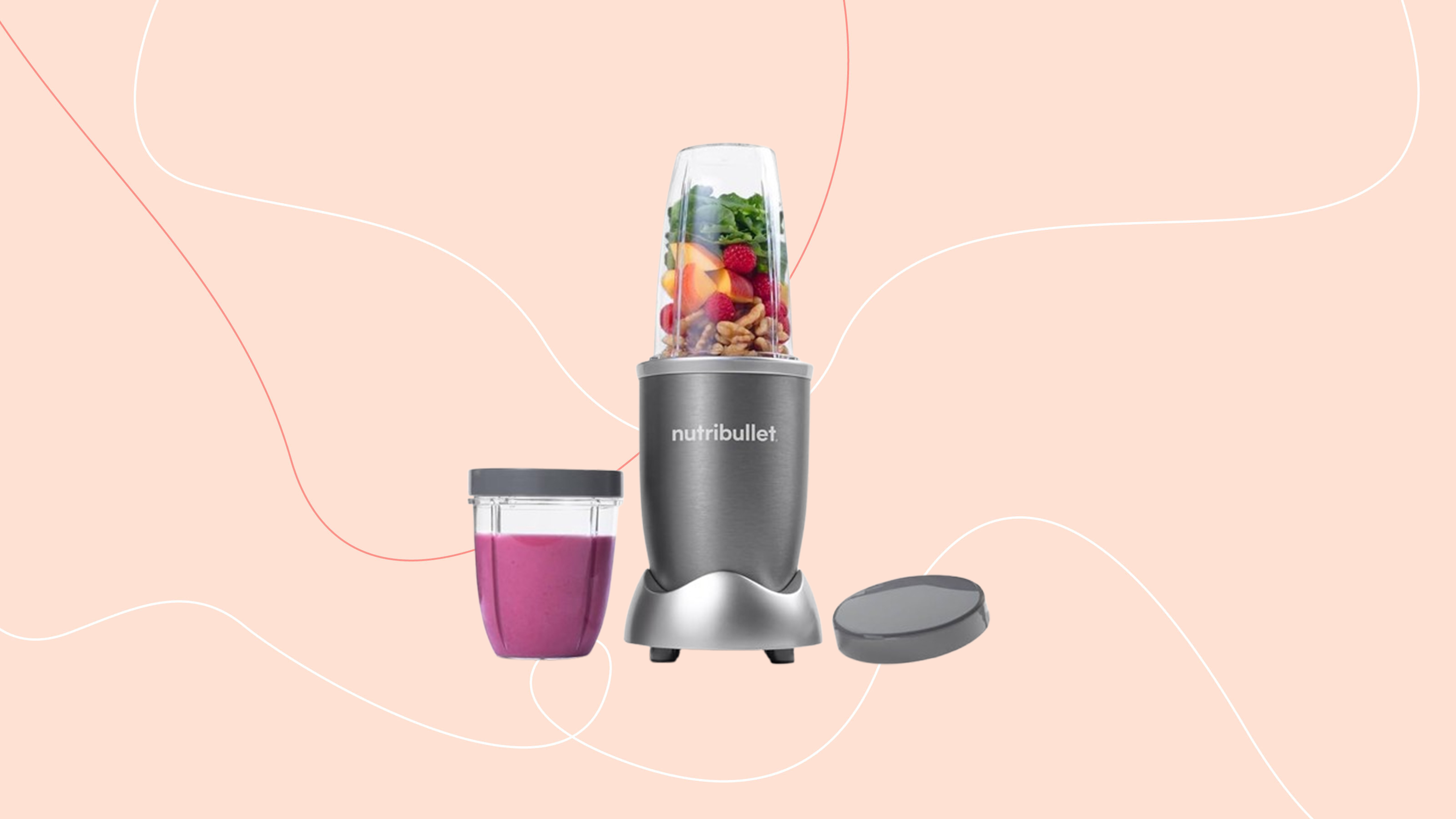
The Nutribullet 600 Series was able to liquidise pretty much every ingredient I put in it, though some harder foods need an extra minute to ensure they get fully pulverised. On the whole I think this entry-level Nutribullet personal blender will fit the bill for most people.
-
+
Easy to use
-
+
Comes with two cups
-
+
Blending power is enough for most ingredients
-
+
Dishwasher safe accessories
-
-
Doesn’t come with a to-go lid
-
-
Not the most powerful Nutribullet you can buy
Why you can trust Ideal Home

Nutribullet is a household name, a brand that needs no introduction. And out of the many blenders you can choose from, the Nutribullet 600 Series is the brand's most popular personal blender. That being said, it’s far from the most powerful bullet blender they make, so can its performance rival the best blenders on the market?
Whether you’re looking to make fruit and vegetable smoothies, milkshakes, or post-gym protein packed drinks, a personal blender is a convenient solution. Also known as bullet style blenders, they mix your ingredients directly in the cup, saving on the washing up.
I’m no stranger to a breakfast smoothie and I love a milkshake, so I’ll give this Nutribullet a thorough test. And because it’s the least powerful Nutribullet in their line-up of plug-in personal blenders, I’m particularly interested to see how it copes with small seeds, hard nuts, and leafy greens. Scroll on to see how it fared.
Nutribullet 600 Series product specs

- Height with tall cup installed: 35cm
- Accessories: 680ml tall cup, 511ml short cup, handled lip ring, solid lid, extractor blade
- Watts: 600
- Dishwasher safe? Yes
Unboxing and first impressions
As you’d expect, the Nutribullet 600 comes in a compact box, and the packaging is mostly cardboard. However, all the components are individually wrapped in plastic bags, which does seem somewhat unnecessary to me.
In addition to the motor, there are two different size cups, a screw on blade attachment, a solid lid, and a screw on handle for drinking directly from the cup. Assembling the various parts is straightforward, as is the operation of the blender.

To get blending, all you have to do is fill the cup, not exceeding the MAX line, attach the blades and then upend it and sit it on the motor. Blending will start when you press down on the cup and twist to lock it in place. Then to stop blending, simply twist it anti-clockwise.
It doesn’t come with a to-go lid for the cups. But if you like to take your smoothies out of the house, you can buy one of these separately for around £4 on the Nutribullet website.

There are some recipes included in the box and the instruction manual contains helpful hints on using the Nutribullet. Some things I noticed when reading through it, that are worth pointing out, are that you can’t use it to crush ice or blend hot foods.
Furthermore, it says you shouldn’t blend for more than one minute at a time. And that if you need to blend for longer, you should leave at least a one minute gap between each blending cycle to allow it to cool. So given that there isn’t a timer on the blender, presumably I’m going to have to set a timer on my phone to make sure I don’t exceed the one minute limit.
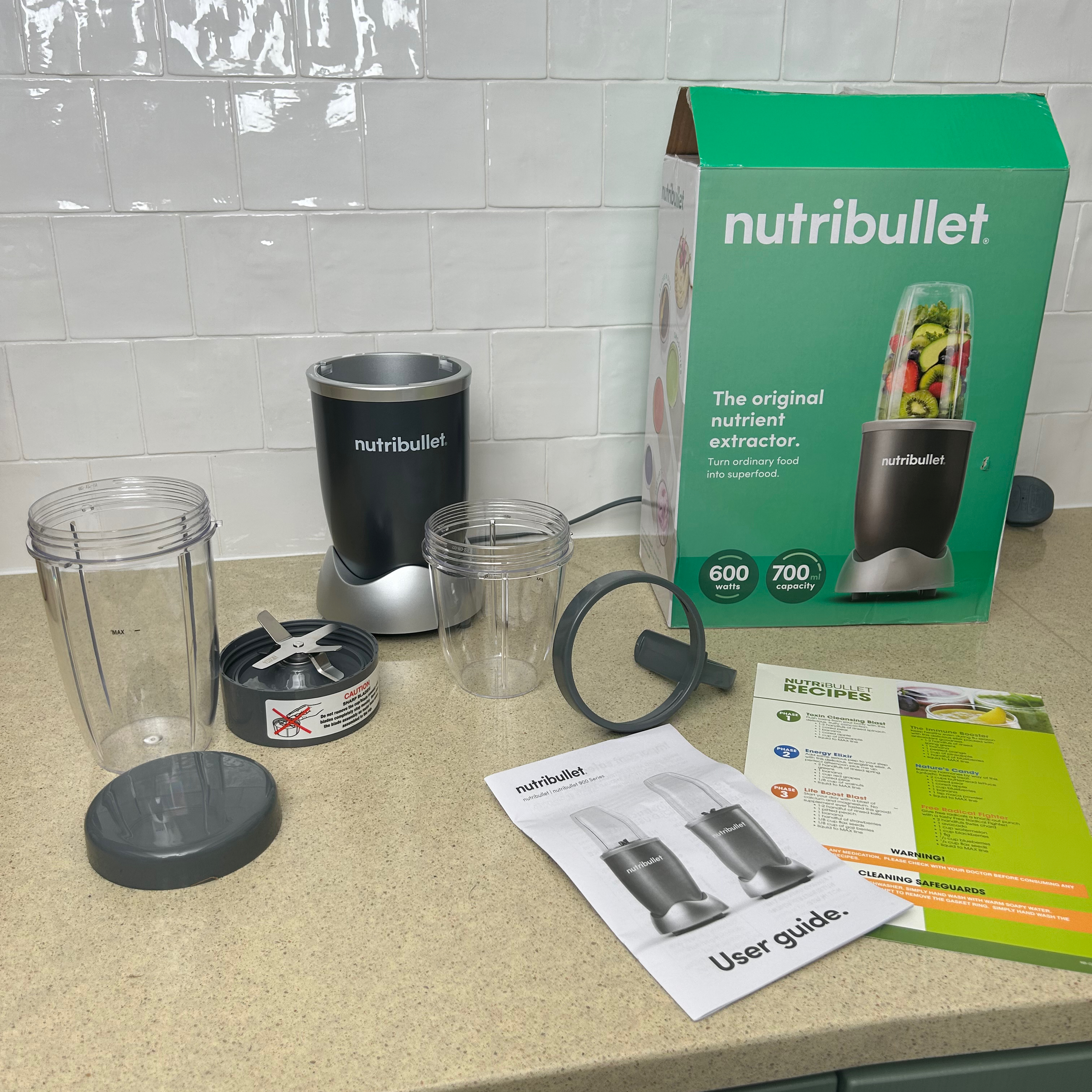
Additionally, you can’t use the extractor blade for grinding dry ingredients like grains, cereal, or coffee. Essentially, there always needs to be some liquid in the mix.
The manual also advises replacing the blades after 6 months of use. But I think you can use a bit of common sense here. The frequency will very much depend on how often you use the blender. At the time of writing a new extractor blade costs just £9.99 so it’s not a huge investment if you notice the blade starting to dull.
Aside from the cost though, it does feel quite wasteful and not the most environmentally conscious practice. So I don’t feel great about having to replace it this frequently.
What is it like to use?
For my first smoothie I blitzed up a sliced frozen banana with a small handful of cashew nuts, a scoop of protein powder, and a tablespoon of cocoa powder, topped up with almond milk. After blending for one minute, it looked smooth, so I left it there.
There was a bit of cocoa powder stuck to the bottom of the cup, but on the whole the drink was smooth and well liquidised with a slightly aerated texture.

There wasn’t any grittiness from the nuts, but when I got to the last few sips of the drink, I discovered a few chunks of unblended cashew nut lurking at the bottom. So it may have benefitted from a little extra blending time.

Next I used the smaller cup to blitz up a quick salsa mix. I threw in a roughly chopped spring onion with whole cherry tomatoes, a handful of coriander, a good squeeze of lime juice and a chunk of chilli.
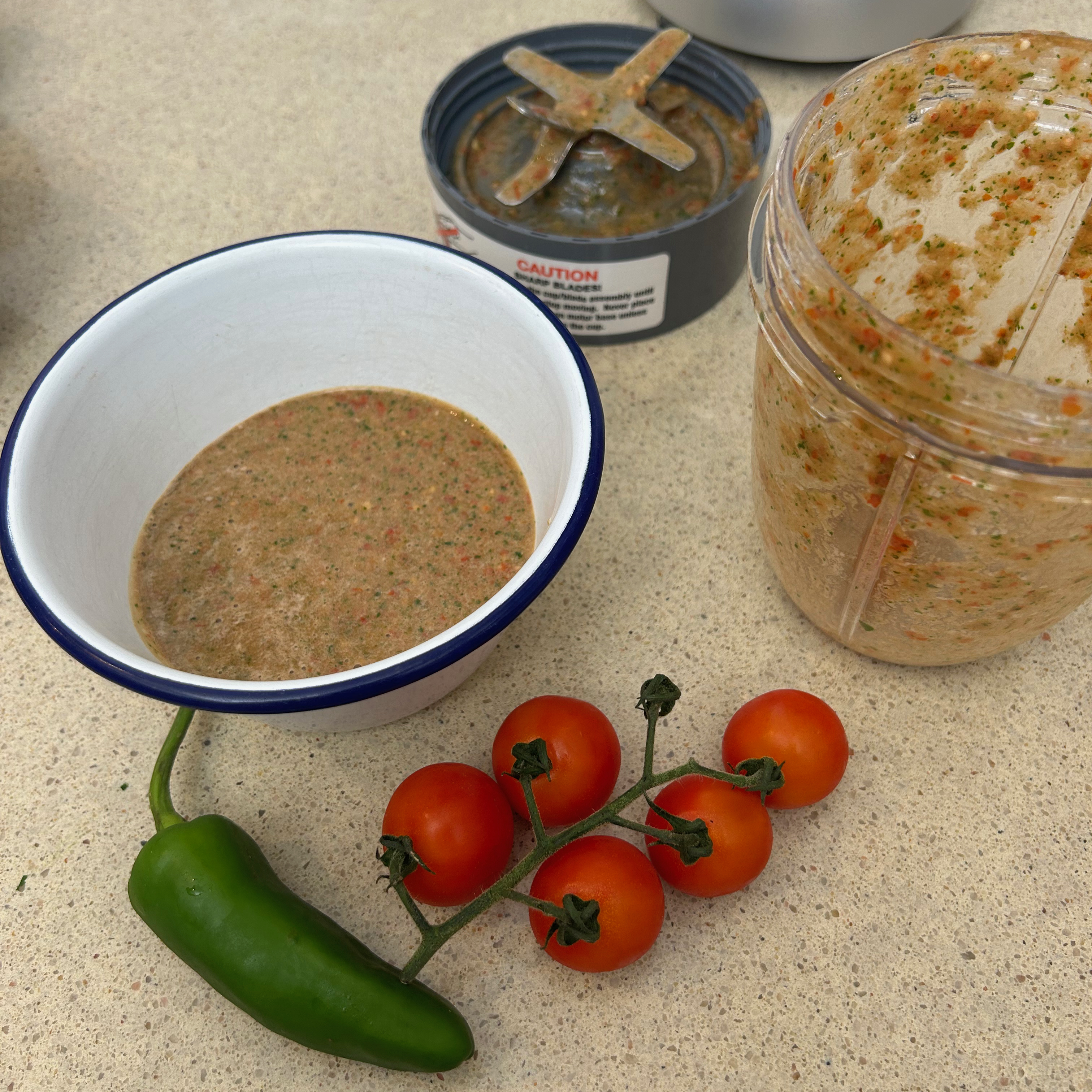
I didn’t want it completely liquidised so I blended the salsa mix for just 15 seconds. This was plenty of time to finely chop and mix all the ingredients into a speedy, tasty salsa. I then used the solid lid to store it in the fridge for a couple of hours until I needed it. I was super happy with the result and it took only a few seconds.
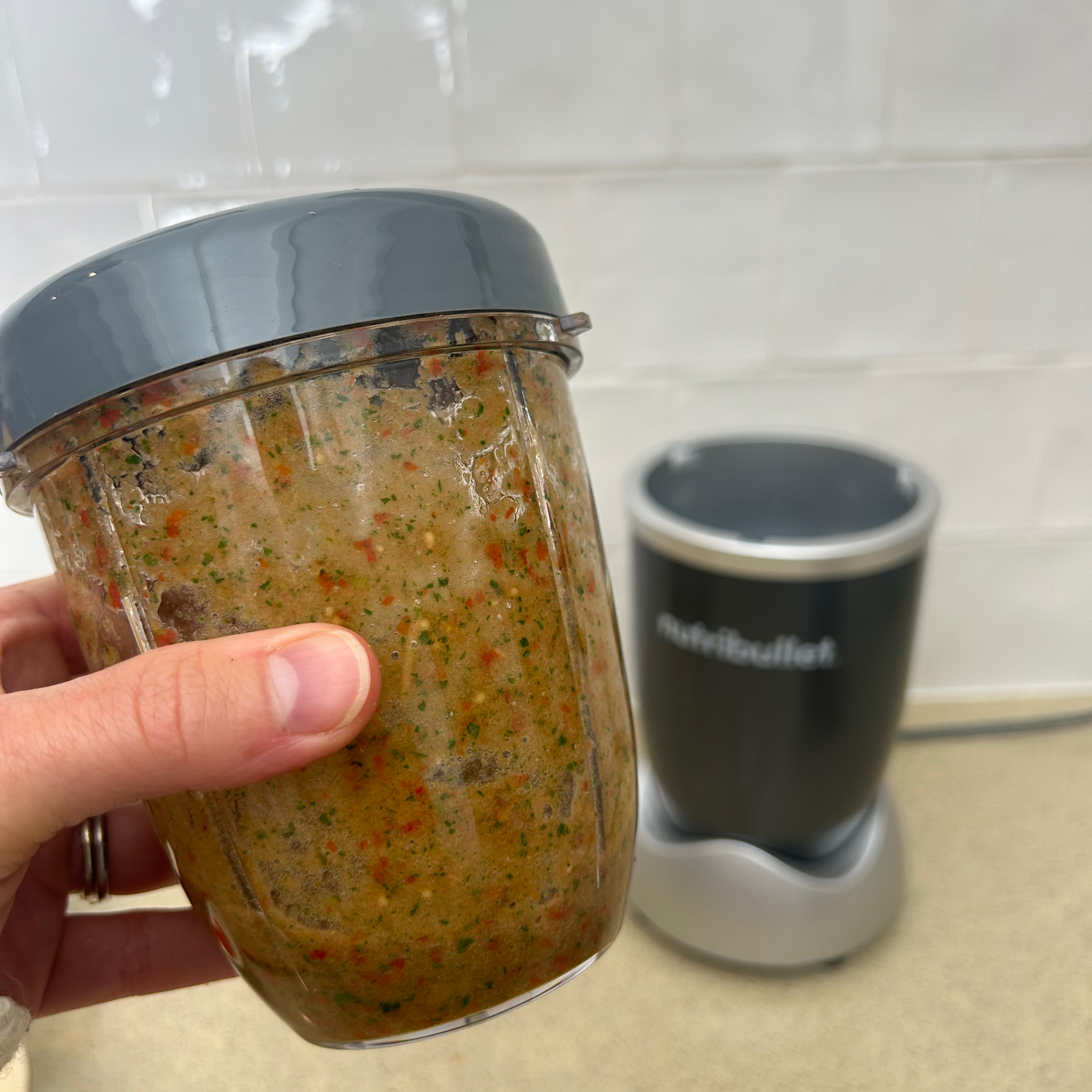
The recipe leaflet recommends making what it calls a NutriBlast. This is 50% leafy greens and 50% fruits. I used spinach and frozen mixed berries, I also added a couple of spoonfuls of mixed seeds and topped up with almond milk.
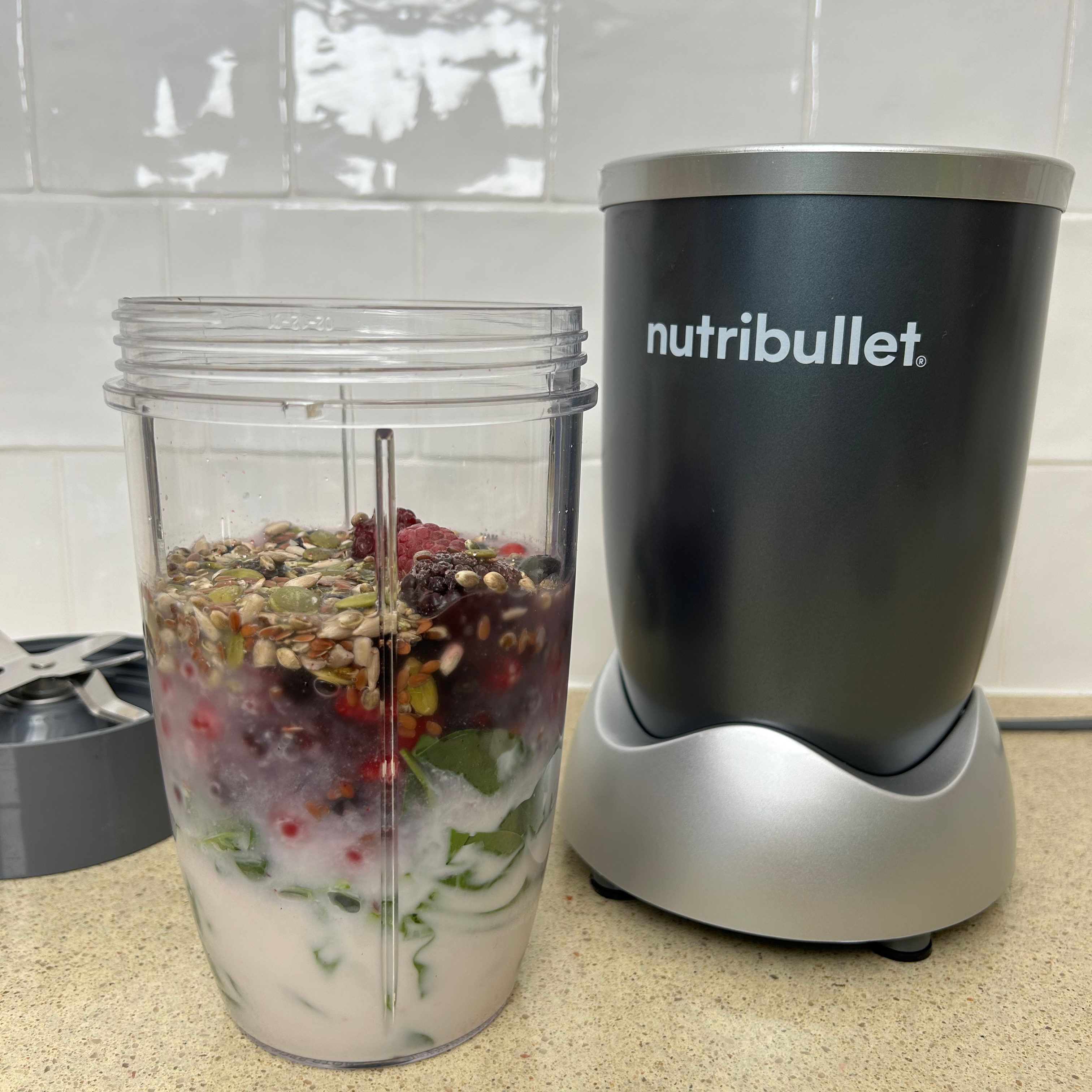
After the first one minute blend, the green spinach leaves had been completely obliterated. And though there were no whole seeds left, the drink had an overly gritty texture, so I blended it for a second minute.
The second blend didn’t manage to make the drink completely smooth, there were still some tiny gritty seeds from the frozen berries. That said, it was vastly improved and thankfully there were no stray berries or leaves that hadn’t been blitzed. Overall it was pleasant to drink.

Pancake batter was next on the agenda and I made a banana pancake batter with an overripe banana, egg, milk, and flour. I popped all the ingredients into the blender for 45 seconds and then used a spatula to scrape down the sides as it was a very thick batter and I could see some flour was sticking.
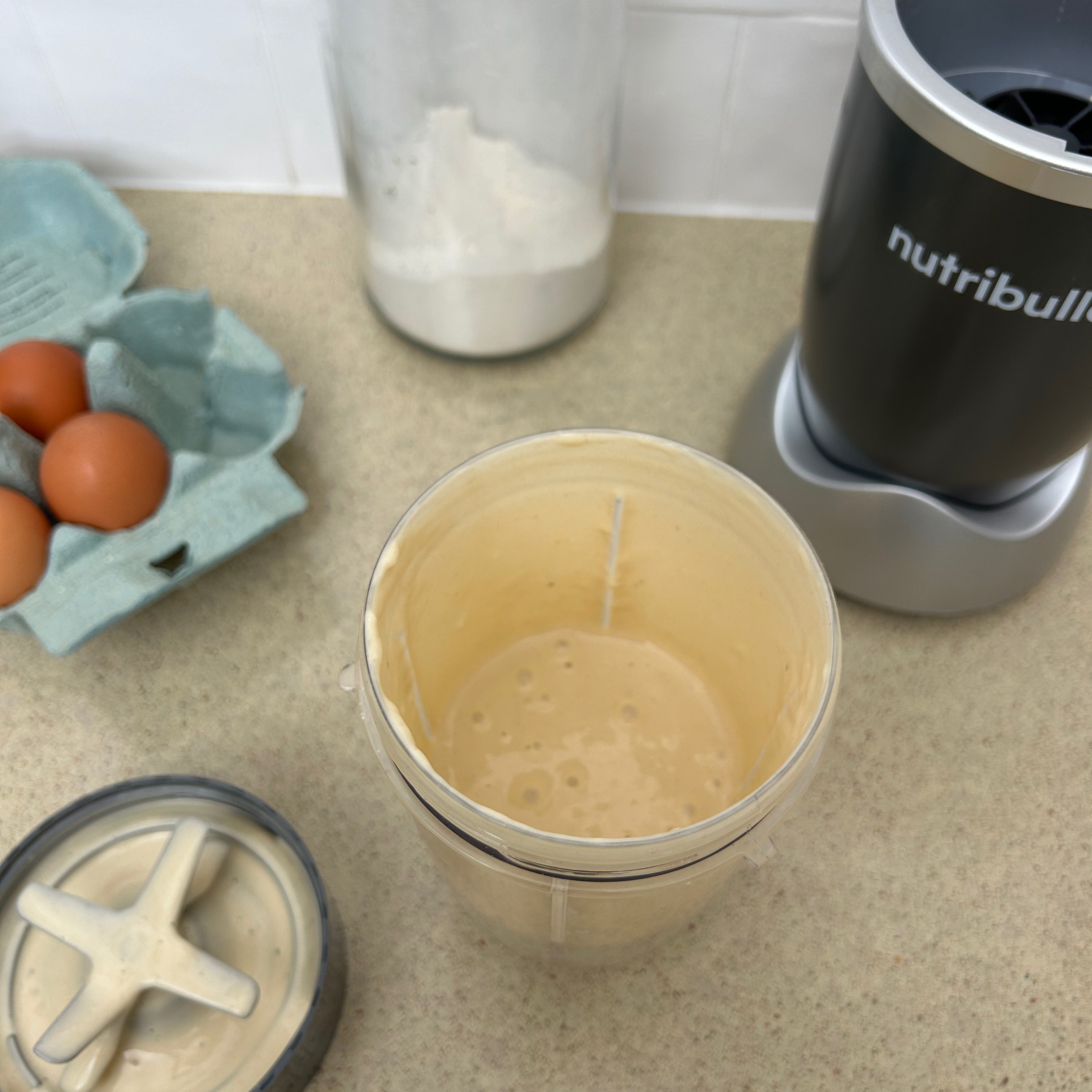
I gave it another 30 seconds or so to make sure it blended to a super smooth batter and then poured it straight from the cup into the frying pan. It was easy and convenient and my pancakes were light and fluffy.
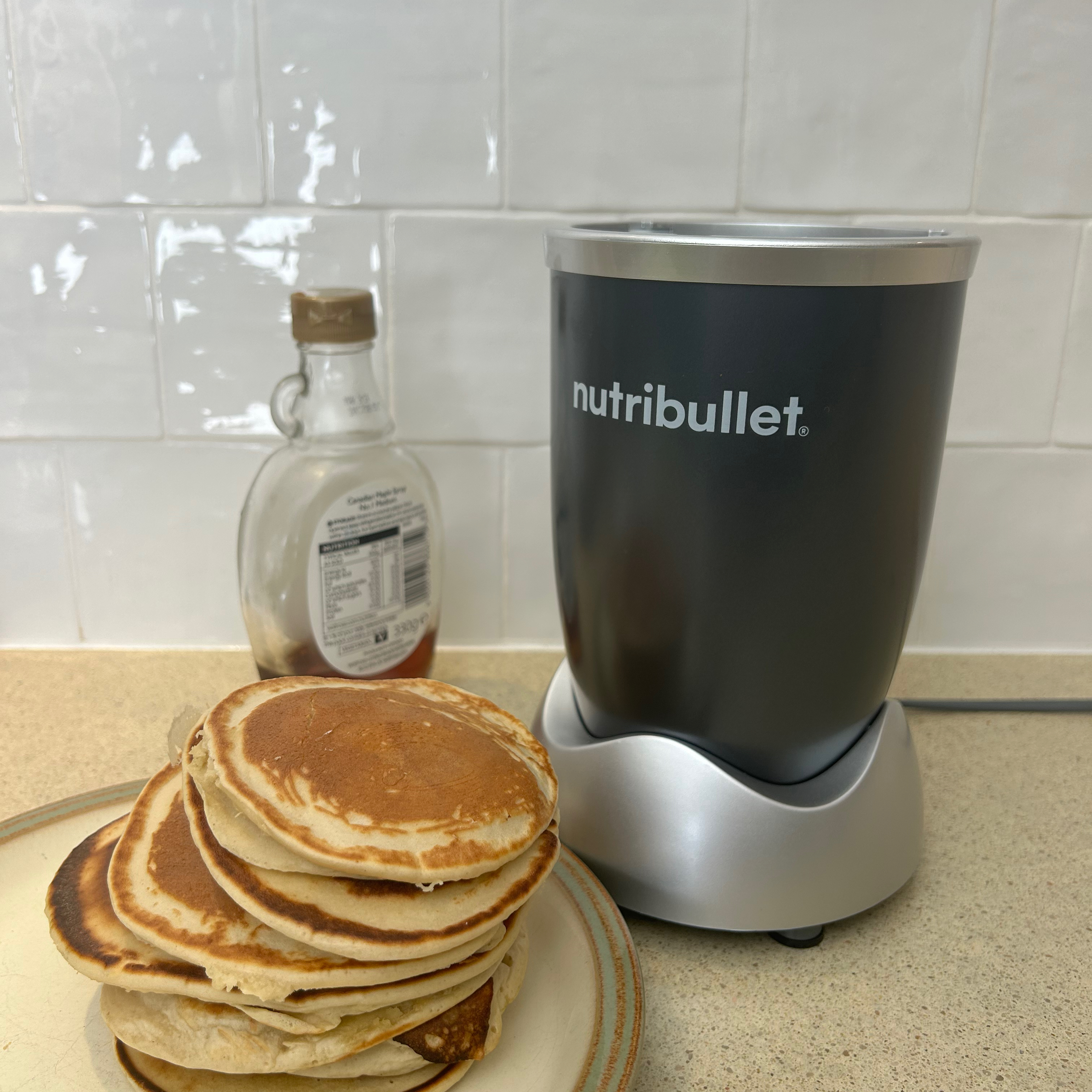
This blender is strictly for cold ingredients. So when I wanted to make a homemade turmeric latte, I added all my spices and milk to the small cup and blitzed for a full minute so they were well mixed, then all I had to do was heat the mixture in the microwave. Job done.
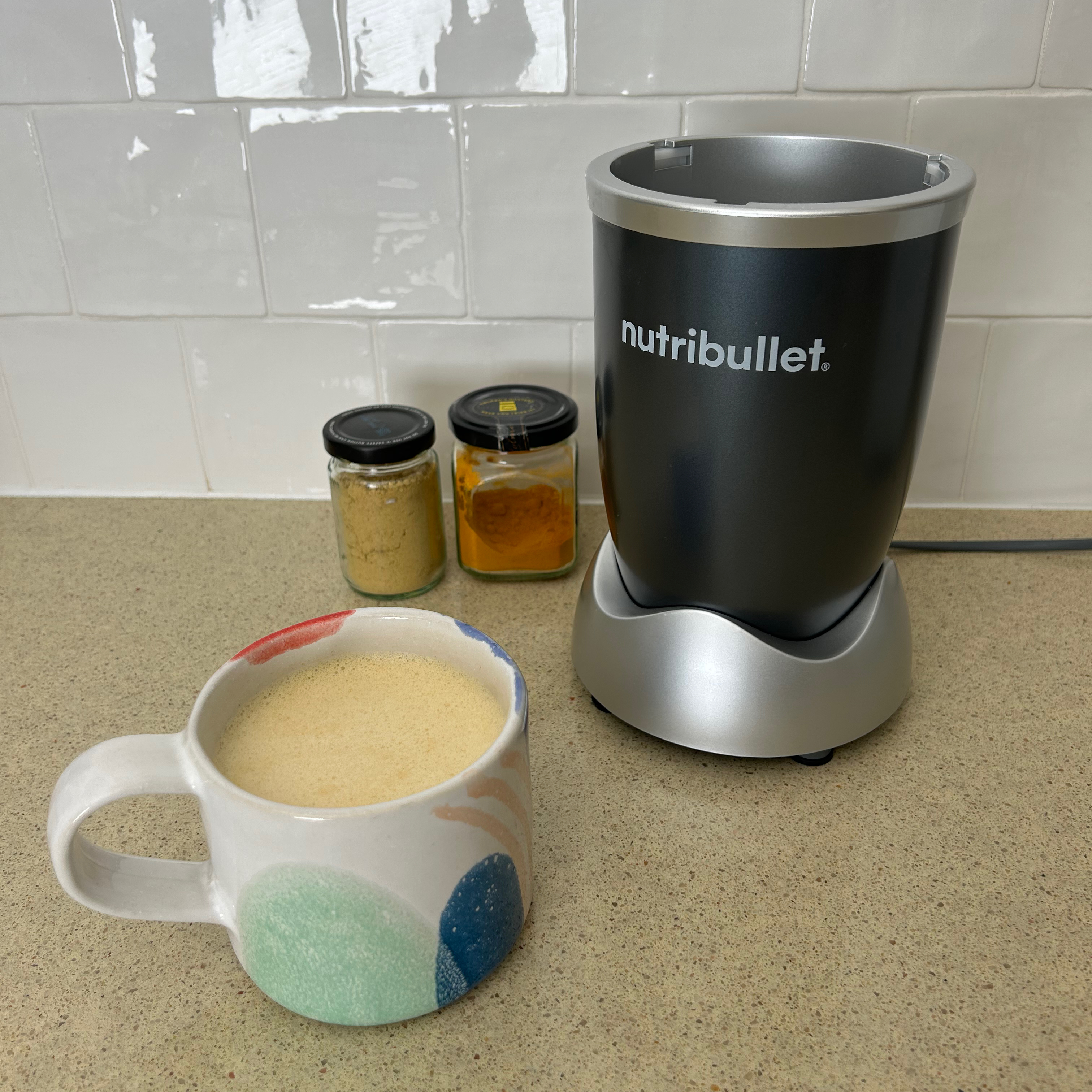
Lastly, I made a carrot cake smoothie. For this I added sliced raw carrot, vanilla protein powder, cinnamon, nutmeg, raisins, oats, Greek yogurt, milk and some ice. After the first 60 second blend I could still see some chunks of raisin, so after leaving it for 60 seconds for the Nutribullet to cool, I switched it on for a second full 60 second blend.

I’ve made this particular smoothie a lot, and due to the hard, fibrous nature of the carrot, it can be quite a gritty, fibrous drink, especially in lesser quality blenders. However, I was pleasantly surprised at how smooth this drink was, not at all gritty or pulpy.
Unfortunately when I got to the end of the smoothie, I discovered all the raisins. They were barely chopped and had sunk to the base of the cup. This was a bit of a shame, and next time I’d just leave them out altogether. Aside from the raisins though, I was very impressed with the quality and texture of this smoothie.

Like most blenders it’s noisy when in use. My noise meter registered around 90dB when standing right beside it. But since it’s only recommended to be used in short one minute bursts, the noise is never a big issue, in my opinion.
Cleaning
The cups, solid lid and handled lip ring can all be washed on the top rack of the dishwasher. It’s best to clean them soon after use, and if you do that, then often a quick rinse is all that’s needed. I tended to wash them by hand but they cleaned well in my dishwasher too.
The blade assembly can’t go in the dishwasher, and again, as long as you rinse it immediately after use, then cleaning needn’t be tricky. I found that the power of the water from my tap was usually enough to dislodge all residues. But as it’s a blade you do have to be careful and I recommend tackling anything stubborn with a long-handled brush rather than a cloth.
How does it compare to similar blenders?
If you want a personal blender with more in the way of functionality and settings, take a look at the Ninja Auto-IQ BN495UK. It’s slightly more expensive, but offers preset blending cycles that vary the blending pattern to ensure all ingredients are pulverised. Its 1000W motor means it’s incredibly powerful and the two 700ml cups come with handy to-go lids.
Alternatively, if you want to blend your protein shakes while you’re still at the gym, I recently tried the cordless rechargeable Nutribullet Portable Blender. It won’t compete in terms of power but it’s an affordable blender for making simple drinks on-the-go.
Should you buy the Nutribullet 600 series blender?
There’s a reason this is Nutribullet’s most popular personal blender. It combines an affordable price tag with enough blending power to satisfy most people's smoothie making needs. Of course you can spend more on a Nutribullet with more power, and that’s probably advisable if you want to pulverise lots of hard ingredients regularly. But for the majority of people, the 600 series will get the job done.
The tall cup is the ideal size for a filling breakfast smoothie for one, or a smaller tasty nutritious drink for two. Admittedly, I don’t love how frequently they advise replacing the blades. And as I mentioned earlier, if you want to make smoothies to-go, you’ll have to purchase an additional lid.
Blending performance is generally very good. Some harder ingredients required a second blend to ensure they were properly blitzed. But on the whole it’ll create tasty, smooth drinks in 60 seconds. Plus it can be used for batters, sauces and even cocktails, so it's more versatile than you might think.
About this review, and the reviewer:
After completing a Home Economics degree, Helen went on to work for the Good Housekeeping Institute and has been reviewing home appliances ever since. She lives in a small village in Buckinghamshire in the UK, where she reviews all sorts of home and garden appliances using her wealth of experience.
Helen used the Nutribullet 600 Series in her own home for several days. She put it to the test pulverising a range of ingredients into delicious smoothies and drinks.
Get the Ideal Home Newsletter
Sign up to our newsletter for style and decor inspiration, house makeovers, project advice and more.

After completing a Home Economics degree, Helen went on to work for the Good Housekeeping Institute and has been reviewing home appliances ever since. She lives in a small village in Buckinghamshire in the UK, where she reviews all sorts of home and garden appliances for Ideal Home using her wealth of experience.
-
 This £200 limited-time discount makes this Dyson vacuum cheaper than I’ve ever seen it - run don’t walk to Argos for this bargain
This £200 limited-time discount makes this Dyson vacuum cheaper than I’ve ever seen it - run don’t walk to Argos for this bargainIt's the most affordable Dyson on the market right now
By Lauren Bradbury
-
 Martin and Shirlie Kemp’s pastel flower beds have given their Victorian renovation a romantic look - how you can get the look
Martin and Shirlie Kemp’s pastel flower beds have given their Victorian renovation a romantic look - how you can get the lookTheir pastel garden is the cottage garden inspo you've been looking for
By Kezia Reynolds
-
 IKEA has just launched a massive 96 new products - but these are the only pieces you need to pay attention to
IKEA has just launched a massive 96 new products - but these are the only pieces you need to pay attention toThe classic STOCKHOLM collection just got even better
By Kezia Reynolds